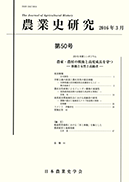56 巻
選択された号の論文の10件中1~10を表示しています
- |<
- <
- 1
- >
- >|
-
2022 年 56 巻 p. 1-
発行日: 2022年
公開日: 2023/03/15
PDF形式でダウンロード (139K) -
2022 年 56 巻 p. 3-11
発行日: 2022年
公開日: 2023/03/15
PDF形式でダウンロード (358K) -
2022 年 56 巻 p. 13-25
発行日: 2022年
公開日: 2023/03/15
PDF形式でダウンロード (503K) -
2022 年 56 巻 p. 27-37
発行日: 2022年
公開日: 2023/03/15
PDF形式でダウンロード (593K) -
2022 年 56 巻 p. 39-41
発行日: 2022年
公開日: 2023/03/15
PDF形式でダウンロード (237K) -
2022 年 56 巻 p. 43-47
発行日: 2022年
公開日: 2023/03/15
PDF形式でダウンロード (278K) -
2022 年 56 巻 p. 49-50
発行日: 2022年
公開日: 2023/03/15
PDF形式でダウンロード (213K) -
2022 年 56 巻 p. 51-55
発行日: 2022年
公開日: 2023/03/15
PDF形式でダウンロード (323K) -
2022 年 56 巻 p. 57-68
発行日: 2022年
公開日: 2023/03/15
PDF形式でダウンロード (472K) -
2022 年 56 巻 p. 69-81
発行日: 2022年
公開日: 2023/03/15
PDF形式でダウンロード (510K)
- |<
- <
- 1
- >
- >|
